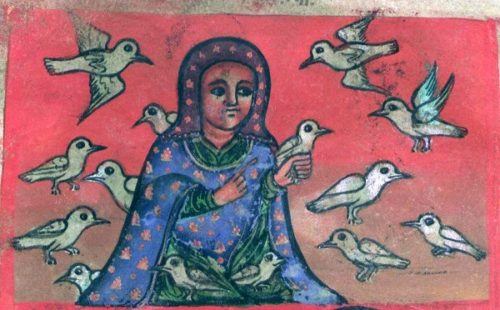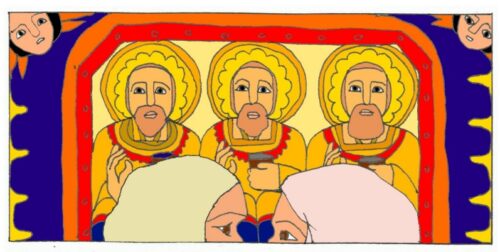Last Updated on November 28, 2023 by Kittredge Cherry

Walatta Petros is a 17th-century Ethiopian nun and saint who had an intense lifelong friendship with another nun and led a successful movement to drive out foreign missionaries. Her feast day is Nov. 23.
Her biography, written by her disciples just 30 years after her death, contains the earliest known depiction of same-sex desire among women in sub-Saharan Africa. That section was censored until 2015, when the first English translation was published.
Walatta Petros is recognized as a saint by the Ethiopian Tewahedo Orthodox Church, which honors her for preserving early African Christian beliefs by expelling Portuguese Jesuit missionaries.
Controversial evidence of same-sex love in her history is revealed in her biography: “The Life and Struggles of Our Mother Walatta Petros: A 17th-Century African Biography of an Ethiopian Woman” by Galawdewos. Written in 1672, it was published in English for the first time in 2015. Wendy Belcher, associate professor of African literature at Princeton University, translated and edited it with Michael Kleiner. It is the earliest known book-length biography of an African woman.
“She was a fierce female leader who did not suffer fools, conquered kings, and was much beloved,” Belcher said. “Her miracles generally involved helping her followers escape murderous state power and making sure that the bread and beer didn’t run out.”
Walatta Petros lived in mutual love with another nun
Walatta Petros (1592 – 1642) was a noblewoman who married at a young age. Her name is a compound meaning “Daughter of (Saint) Peter” and cannot be shortened. She gave birth to three children who all died in infancy. Then she left her husband, shaved her head and became a nun.
The biography vividly describes the day she met Eheta Kristos (1601-1649), another noblewoman who had given up married life to become a nun. Her name means “Sister of Christ.” The moment they met sounds like love at first sight:
“As soon as our holy mother Walatta Petros and Eheta Kristos saw each other from afar, love was infused into both their hearts, love for one another, and… they were like people who had known each other beforehand because the Holy Spirit united them.”

Love at first sight infused their hearts when Walatta Petros and Eheta Kristos met. The dramatic moment is pictured by Dutch artist and priest Jan Haen in “Heavenly Homos, Etc.: Queer Icons from LGBTQ Life, Religion, and History.” The book tells the life stories of Walatta Petros and many other LGBTQ saints.
Before long they moved in together. The text uses language that evokes a marriage bond, saying that they “lived together in mutual love, like soul and body. From that day onward the two did not separate, neither in times of tribulation and persecution, nor in those of tranquility, but only in death.”
Belcher’s introduction points out that it would be “anachronistic” to identify Walatta Petros as a lesbian because it is a 20th-century Anglo-American term. Instead she says in the introduction that the two nuns were “involved in a lifelong partnership of deep romantic friendship,” noting that and they were committed to celibacy and asceticism.
Indeed the chapter newly translated as “Our Mother Sees Nuns Lusting After Each Other” describes how Walatta Petros objected to such behavior. The saint herself tells the story in the text:
“It was evening and I was sitting in the house, facing the gate, when I saw some young nuns pressing against each other and being lustful with each other, each with a female companion. Therefore my heart caught fire and I began to argue with God, saying to him, ‘Did you put me here to show me this?’”
The footnote in the book explains that the phrase “my heart caught fire” might have a double meaning: “On the surface, it expresses her anger against God for showing her this scene, but the words chosen also suggest that she is angry because she felt desire upon looking at the scene.”
Some Ethiopians reject this interpretation, and Belcher’s website includes a page devoted to the “Controversy over Sexuality in the Gadla Walatta Petros.” Debate continued in 2020 with a Change.org petition denouncing the book and a rejoinder defending it.
Walatta Petros had ties to early church
The church that Walatta Petros served was one of the earliest forms of Christianity, the Ethiopian Tewahedo Orthodox Church. It was established officially in the fourth century but may trace its roots back to the Ethiopian eunuch who was baptized by Philip in the New Testament. There were only a few such pre-colonial Christian churches in the world.
During Walatta Petros’ lifetime, Jesuit missionaries came from Portugal and tried to convert the Ethiopians to Roman Catholicism. The Ethiopians found heresy in some Catholic doctrines, such as Original Sin. Instead the Ethiopians believed in transformation of human beings by grace. Walatta Petros led a successful nonviolent movement that expelled the Jesuits in 1632 and preserved Ethiopia’s ancient form of Christianity.
In addition her biography describes how she founded seven religious communities — the first in Sudan and the rest around Ethiopia’s large Lake Ṭana.
The account also humanizes the saint with lively dialogue and colorful details from daily life. Some chapter titles reveal conflicts similar to those encountered by women church leaders today, such as “Male Leaders Work Against Our Mother” and “Envious Monks Attack Our Mother’s Authority.”
There are also charming scenes of Walatta Petros’ spiritual life. Most dramatic is her debate with Christ when he asks her to care for souls that appear in the form of doves and shining crystal vessels.
Her long-time companion carried on her ministry
After more than two decades as a nun, Walatta Petros fell ill and appointed her long-time companion Eheta Kristos as her successor to head the religious community. Walatta Petros died on Nov. 24, 1642 after a three-month illness. She was 50 years old and had spent 26 years as a nun. Belcher points out in her introduction that their loving bond lasted until death:
“Upon her deathbed, Walatta Petros’ last thoughts and words were about her friend, worrying about how Eheta Kristos would fare without her, saying three times, ‘She will be disconsolate; she has no other hope than me!’”
Ehelta Kristos went on to lead the community for almost seven years until her own death on April 2, 1649.
There are no known images of Eheta Kristos, but she is undoubtedly one of the mourners in the image of the whole community mourning when Walatta Petros died.
Death does not end Walatta Petros’ biography, since it also serves as a hagiography. The book continues with 27 miracles that she performed after she departed to eternal life. They include dramatic healings as well as more down-home assistance such as repairing a broken jar of ale and recovering a stolen book of poems.
Belcher, who spent much of her childhood in Ethiopia and Ghana, learned the Gəˁəz language in order to translate the biography known as Gädlä Wälättä P̣eṭros. She and Kleiner also worked on the translation with other experts, including an Ethiopian priest. She is one of the few Westerners who have studied the 340-year-old parchment manuscript, which is housed in a monastery near Lake Tana. Belcher visited local nuns and monks while searching for copies of the manuscript at Ethiopia’s remote monasteries.
She discusses Walatta Petros and Eheta Kristos in depth in her lecture on “Same-Sex Intimacies in an Early Modern African Text about an Ethiopian Female Saint,” which is available as a YouTube video. She also has an article on the topic “Same-Sex Intimacies in the Early African Text Gädlä Wälättä P̣eṭros (1672) about an Ethiopian Female Saint” in Research in African Literatures, June 2016.
The book on Walatta Petros is lavishly illustrated with images from illuminated manuscripts, some of which are posted here today. This 500-page book is much more than a translation, featuring thousands of footnotes and hundreds of pages of contextual and scholarly information based on comparing twelve different manuscripts.
Some manuscripts and the new book conclude with two praise poems about Walatta Petros. One celebrates the saint from head to toe, including her breasts and womb. The other is a hymn that begins:
Hail to you, Walatta Petros, a garden! Wrapped in heavenly scent,
you are shade for the doves, from the heat of misery
that fills our world.
Links related to Walatta Petros
To read this article in Italian, go to:
L’amore tra donne raccontato nell’agiografia africana della santa etiope Walatta Petros (Gionata.org)
The Two Rebeccas: Queer black pair founded Shaker religious community in 1800s
___
Top image: Walatta Petros receives souls in the form of doves as a gift from Christ (Credit: SLUB Mscr.Dresd.Eb.415.e,2)
____
This post is part of the LGBTQ Saints series by Kittredge Cherry. Traditional and alternative saints, people in the Bible, LGBTQ martyrs, authors, theologians, religious leaders, artists, deities and other figures of special interest to lesbian, gay, bisexual and transgender and queer (LGBTQ) people and our allies are covered.
This article was originally published on Q Spirit in November 2016, expanded with new material over time, and most recently updated on Nov. 23, 2023.
Copyright © Kittredge Cherry. All rights reserved.
Qspirit.net presents the Jesus in Love Blog on LGBTQ spirituality.

























Well, at least you admit she was chaste and actually opposed same-sex lust, while nonetheless describing her as if she was in a romantic relationship with another woman just because of a word being translated as “love” in English. The reason so many Ethiopians have criticized this is simply because the original language doesn’t imply anything of the sort. The trouble with all such translations is that in modern English the word “love” now almost always means “romance” but that didn’t used to be the case even in English; and in most other languages (especially in the past) the equivalent terms usually meant any type of affection.
Thank you so much for spreading the word of god. I am sure any Ethiopian, especially in the Christian community knows what are those words mean.
Okay, this is so very disrespectful to us Ethiopians. The Ethiopian culture usually understands an innocent concept of love unless it is lust and the meaning is obviously different with European or Arab cultures. When a woman says she loves another in Ethiopia, she isn’t implying to fornicate! You people don’t understand you just suffer from a disgusting, perverted mindset but only determined to claim it is caused biologically!
you obviously did not read the entire thing. you say “she isn’t implying to fornicate!” DUH. The article literally states her objection to that physical lust. You gon come all the way to a queer website to not even read the article and just comment homophobic hate, doesn’t that seem a bit crazy to you? have you no hobbies?
Well, maybe the queer website should stop culturally appropriating Ethiopian Orthodox Saints.
Wendy Belcher is a manipulator. The translation she used of Mahaza could be lover or friend in different sex relationship. Same with the word Arkay which if used in same sex context it means friends but when its different sex it means girlfriend or boyfriend in modern day standards.
The concept of homosexuality is not apparent in Ethiopian or Eritrean culture. It is an Arab and European concept. Her interpretation is false and quite frankly misleading
I think-from what we have-that the woman was atleast attracted to women.
Since queerness/lesbianism/same sex attraction is most likely caused by biological causes (genetics or womb environment) and perhaps affected by a history of sexual abuse in some cases.*
So it’s very unfair to blame homosexuality on Middle Eastern and Western culture, since it is part of the human condition.
Even this LGBT website acknowledges that the saint did not act upon her attractions (just as heterosexual saints resisted their attraction to the opposite sex.)
*For some women who have been abused by men, they seem to be put off men as a general category, but generally the causes seem to be inherent to the person (nature) rather than nurture.
Homosexuality is everywhere – and has always been so. Read this for example https://www.theguardian.com/commentisfree/2014/mar/08/african-homosexuality-colonial-import-myth
Some manuscripts and the new book conclude with two praise poems about Walatta Petros. One celebrates the saint from head to toe, including her breasts and womb. The other is a hymn that begins:sorry word no good
Thank you, Charles, for affirming my presentation of Walatta Petros and the scholarly work about her. My heart is glowing after reading your comment on “our beloved Kittredge Cherry.” It reminds me of the “beloved community” described by Martin Luther King. In these times it is important to appreciate each other. I give thanks for supporters like you. The Thanksgiving holiday starts in a few hours so… happy Thanksgiving!
No it lies and never had any such lifestyles in our country!!! Keep this sinful nature to yourself!
Thanks for your comment, Ethiopia. I know that some Ethiopians disagree with how Mother Walatta is presented in the new book. You may find these queer interpretations sinful, but Jesus did not condemn homosexuality. Same-sex attraction is part of human nature as God created us, and occurs in every country and culture.
Scholarship at it’s best is unavoidably dry and demanding I thought until I listened to the talk of Wendy Belcher. She and her fellow translator Michael Kleiner have put together a work of immense collaborative effort and research. When changes are made for a more realistic and humane theology of same sex relationship within the Christian church, their
efforts and those of other scholars, will provide the necessary data for those urgent changes. The heart expands with gratitude to the authors and to our beloved Kittredge Cherry who brings treasures like this book to our attention.